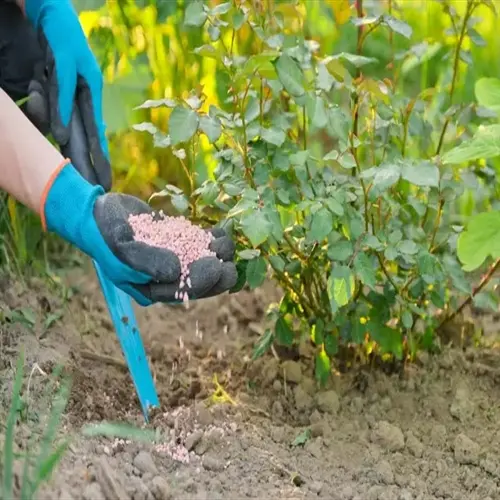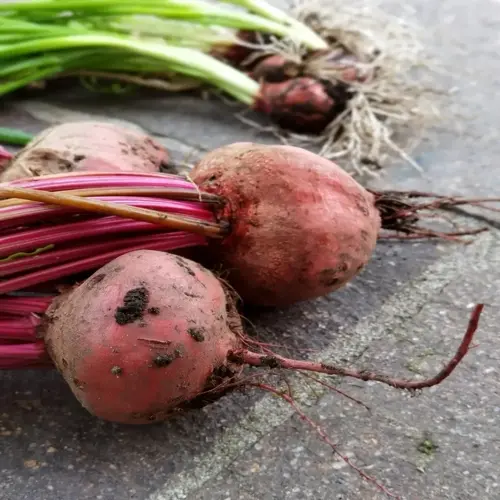5 Signs When to Harvest Cabbage

Written by
Liu Xiaohui
Reviewed by
Prof. Samuel Fitzgerald, Ph.D.Determine the precise harvesting time for cabbage by examining the heads for firmness and compactness.
You can judge readiness when the heads measure comparable to the size specifications of that variety, like a softball diameter.
Keep track of the number of days since the transplant or seed was planted; most varieties can mature in approximately 60-100 days after planting.
Observe outer leaves: If they are deep green and have no separation of the wrapper leaves from the head, the cabbage is ready for harvest.
You should start harvesting when air temperatures get near 80 °F or above to prevent splitting the head.
Use your hands to squeeze the head: a mature cabbage head can resist gentle pressure.
Article Navigation
Recognizing the correct time to harvest cabbage can mean the difference between satisfactory heads and mediocre results. Cabbage is an excellent source of nutrition, rich in high levels of vitamin C and fiber. Cabbage thrives in a garden and can withstand cooler weather with ease.
Ideal timing retains that fresh crunch and avoids bitter or split heads. Too early and heads won't size up; too late and heads become woody. Your timing also impacts how long cabbage stores!
I'm going to provide five distinct indicators to check for cabbage readiness. These practical tests apply to any variety of cabbage, from green to Napa. You will feel better about harvesting at the optimal time, ensuring the best flavor and quality.
5 Signs Your Cabbage Is Ready
The squeeze test helps you easily assess if your cabbage is ready to harvest. Gently press the head with the palm of your hand. A properly matured head feels solid and firm like a baseball. If it has soft spots, it needs more time. You won't need to squeeze hard.
Compared to variety standards,the green varieties should resemble a softball, or roughly 5 inches (12 cm) in width from top to bottom. The Savoy varieties will have heads that enlarge up to 8 inches (20 cm). Once heads begin to form, measure them weekly to track their growth.
Keep an eye on the thermometer. Anything above 80°F (27°C) means you need to harvest it right away. Hot weather causes cabbage to split and bolt. If hot temperatures happen to occur, pick the head, even if it's smaller than you'd like. With cool weather, you can allow more time for growth.
Count days since planting. Most varieties mature between 60 and 100 days. Mark your calendar for transplanting. This timing estimate helps anticipate harvest windows. Pair it with physical checks.
Examine the outer leaves. The deeper green and unblemished wrapper leaves indicate overall readiness for the harvest. A yellowish appearance or damage indicates stress. Healthy outer leaves will protect the head of lettuce during growth and storage. The outer leaves should still be hugging the lettuce head.
Solid Head Firmness
- Apply gentle pressure to the head surface. Mature cabbage feels uniformly solid with no spongy areas, indicating tightly packed leaves. Immature heads yield slightly under pressure.
Size Matches Variety
- Measure head dimensions against variety standards: Green/red types should reach softball size (5 inches/12cm diameter). Napa cabbage requires 9-12 inches (22-30cm) height for proper development.
Days Since Planting
- Calculate exact days from transplanting or seeding. Most varieties mature in 60-100 days; check seed packets for specific timelines. Count days consistently for accurate harvest prediction.
Healthy Outer Leaves
- Examine wrapper leaves for deep green coloration without yellowing or holes. Intact outer leaves protect the head and signal sufficient nutrient absorption throughout growth stages.
Weather Threat
- Monitor forecasts for temperatures exceeding 80°F (27°C). Heat accelerates splitting and bolting; harvest immediately when heatwaves approach, even if heads appear slightly underdeveloped.
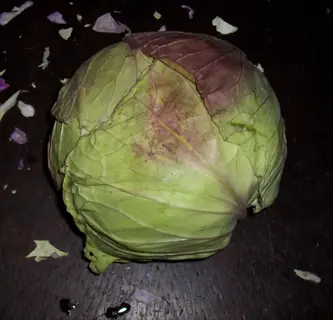
Solid Head Firmness
- Apply gentle pressure to the cabbage head surface using your palm
- Mature heads feel uniformly solid with no spongy or soft areas
- This firmness indicates leaves are tightly packed and fully developed
- Immature heads will yield slightly under moderate pressure
- Test heads every 2-3 days as they near maturity date
- Avoid excessive squeezing that might bruise the vegetable
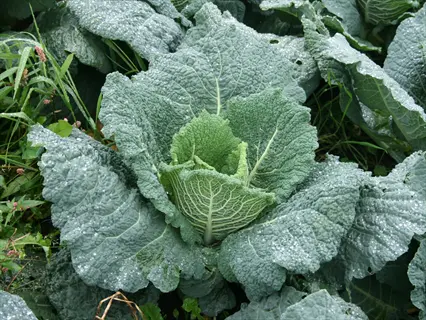
Size Matches Variety
- Measure head dimensions against variety-specific maturity standards
- Green and red cabbage should reach approximately 5 inches (12cm) diameter
- Napa cabbage requires 9-12 inches (22-30cm) height before harvesting
- Compare against familiar objects: green cabbage resembles a softball
- Chinese cabbage forms elongated heads rather than round shapes
- Size requirements vary significantly between early and late-season types
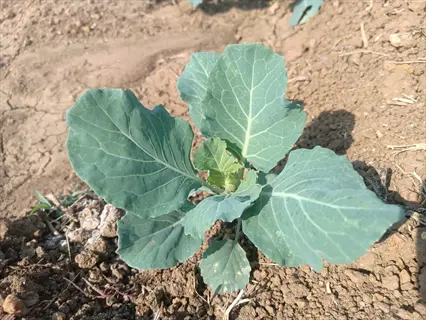
Days Since Planting
- Calculate exact days from transplanting seedlings or direct seeding
- Most varieties mature between 60-100 days depending on type
- Early varieties can be ready in as few as 60 days
- Late-season storage types may require up to 180 days
- Mark planting date on calendar for accurate day counting
- Adjust expectations for weather delays or unusual growing conditions
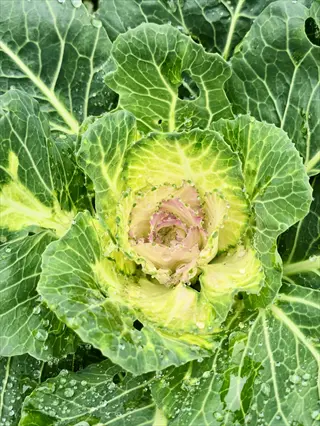
Healthy Outer Leaves
- Examine wrapper leaves surrounding the developing cabbage head
- Healthy leaves show deep green coloration without yellowing
- Intact leaves without major holes indicate good pest management
- Wrapper leaves should be slightly loose but not wilting
- Damaged outer leaves can still protect quality inner heads
- Remove only severely damaged leaves during final inspection
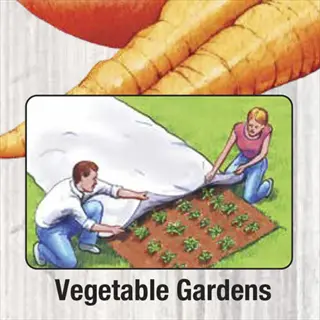
Weather Threat
- Monitor forecasts for temperatures exceeding 80°F (27°C)
- Heat accelerates splitting and triggers premature flowering (bolting)
- Harvest immediately if heatwave predicted within 48 hours
- Slightly immature heads preserve better than split ones
- Morning harvest helps cabbage withstand temperature fluctuations
- Provide temporary shade cloth if harvest must be delayed
Cabbage Varieties and Maturity
Cabbage types exhibit different head shapes, influencing harvest timing. Green and red varieties can create round, compact heads that feel hard when pressed. Savoy types form crinkly heads that are looser, yet still firm up. Napa cabbage produces elongated, cylindrical heads that can grow up to 10 to 12 inches (25-30 cm) in length.
Cold hardiness is quite variable. Savoy survives down to 15°F (-9°C) and is great for fall gardens. Napa needs something warmer above 30°F (-1°C). Red cabbage tolerates 20°F (-7°C) while green types handle 25°F (-4°C). Choose your planned plantings accordingly.
The maturation time ranges from 50 to 110 days. Fast-maturing Napa varieties will be mature in 50-70 days. Green cabbage takes 60-100 days to mature. January King will take 90-110 days, but will store the best. Be sure you count the days from when the strength goes into the ground in the works, not when you started the seed.
Storage capacities are no exception. Tight-headed green cabbage and red cabbage will store for months in root cellars. Savoy's crinkly leaves dry out more quickly, limiting storage to a few weeks. Napa cabbage only stores well for about 3-4 weeks. Choose varieties according to the products you want to preserve..
Step-by-Step Harvesting Technique
Cabbage should be collected in the early morning hours, when you will obtain growth temperatures below 70°F (21°C). Cooler air preserves crispness in heads and prevents wilting. Avoid rooting heads during the midday heat of the day, as this is very stressful and drains moisture from the leaves. Use weather forecasts to avoid days with rain, as this can increase the likelihood of rotting.
The best way to cut cleanly is to use a sharp knife. Always sanitize the blades with rubbing alcohol first. Use one hand to stabilize the head. Cut horizontally across the stem 1-2 inches above the soil. Always keep 2-4 outer leaves as the plant's natural protection.
Use the pulling method in soils with a looser structure. Grasp the base of the plant, near the soil. Gently twist to loosen the roots, while pulling straight up. Then gently shake the soil from the roots. The pulling method often works best at the end of the growing season in larger spaced beds.
Be careful when handling harvested heads to prevent bruising. Remove damaged outer leaves promptly with clean scissors. If they were cut in warm weather, dunk the heads in ice water for 5 minutes. They should be completely air-dried before storage, as mold will form otherwise.
1. Timing Preparation
- Harvest early morning when temperatures are below 70°F (21°C)
- Avoid midday heat which causes wilting and reduced crispness
- Check weather forecasts to avoid harvesting before heavy rains
- Ensure heads have reached maturity signs from previous sections
2. Tool Selection
- Use sharp, sanitized knife or hori hori garden tool
- Disinfect blades with isopropyl alcohol before use
- Bypass pruners work for thicker stems on mature plants
- Gloves protect hands from sharp leaf edges during handling
3. Cutting Method
- Position one hand on top of cabbage head for stability
- Push head gently away from you to expose stem base
- Cut horizontally through stem 1-2 inches above soil level
- Leave 2-4 wrapper leaves intact around head for protection
- Avoid disturbing roots of adjacent plants in dense plantings
4. Pulling Alternative
- Grasp base of cabbage head firmly near soil line
- Twist gently while pulling straight upward
- Shake excess soil from roots before moving plant
- Best for loose soils or end-of-season harvests
- Not recommended for dense garden beds due to root disturbance
5. Post-Harvest Handling
- Trim damaged outer leaves with clean shears immediately
- Dunk heads in ice water for 5 minutes if harvested in warm conditions
- Air-dry heads completely before storage to prevent rot
- Place in shaded area until transported to storage location
- Handle gently to avoid bruising internal leaf structures
Storing Cabbage for Longevity
Refrigeration is effective for short-term cabbage storage of 3-4 weeks. Wrap heads in damp paper towels and place in perforated bags. Maintain high humidity in the crisper drawer, ideally between 32°F and 40°F (0 °C and 4°C).Weekly check for softening or mold.
Root cellars can store cabbage for 3 to 4 months, provided they are given the right environment. Cabbage benefits from 95% humidity at 32-40 ºF (0-4 ºC). Place heads roots-up on shelving or hang them up. Storing heads this way limits moisture loss on the stem scar.
Cabbage is very sensitive to ethylene gas from apples or pears, so it should be stored separately from the fruits to avoid early yellowing. Use separate bins or a dedicated shelf for each type of item. Even small amounts of exposure will hasten deterioration.
For outdoor storage, dig a pit 2 feet deep in a location where the soil drains well. Line the pit with straw and place the heads and roots up. Cover with straw again and a waterproof tarp. This is essentially creating a cellar-like environment to keep them through the winter season.
Refrigeration Method
- Ideal for short-term storage up to 3-4 weeks
- Wrap head in damp paper towel to maintain moisture
- Place in perforated plastic bag allowing air circulation
- Store in vegetable crisper drawer at 32-40°F (0-4°C)
- Check weekly for softening or mold development
- Remove outer leaves if they show deterioration
Root Cellar Storage
- Suitable for long-term storage up to 3-4 months
- Maintain 95% humidity at 32-40°F (0-4°C)
- Place heads roots-up on shelves or hang from ceiling
- Space heads 2-3 inches apart to prevent mold spread
- Layer with straw in crates for insulation in cold areas
- Inspect monthly for rot or pest infestation
Garden Pit/Mound Storage
- Alternative for gardeners without cellar access
- Dig pit 2-2.5 feet (61-76 cm) deep in well-drained area
- Line with 6-inch (15 cm) straw layer for insulation
- Place cabbage heads roots-up in single layer
- Cover with 12-inch (30 cm) straw layer and waterproof tarp
- Weight tarp edges with soil to secure against wind
Preparation Essentials
- Never wash heads before storage - increases rot risk
- Retain 2-4 protective wrapper leaves around each head
- Handle gently to avoid bruising internal leaf structures
- Cure heads in shaded area for 24 hours before storage
- Label varieties with different storage longevity expectations
Troubleshooting Storage Issues
- Softening heads: Increase humidity with damp cloth in storage
- Mold development: Improve air circulation between heads
- Foul odors: Remove decaying heads immediately
- Freezing damage: Add insulation layers during cold snaps
- Ethylene exposure: Relocate storage away from apples/pears
Troubleshooting Common Harvest Issues
Crack/shattered slabs occur as visible cracks where the slab has cracked due to uneven watering or excessive rainfall. Harvest now to avoid losing it all. If the crack happens early, twist the plants slowly (180°) to break the roots. To prevent next season, maintain consistent soil moisture and install rain gauges.
Bolting occurs when temperatures are above 80°F (27°C). Look for flower stalks emerging. You will need to take the whole plant immediately. Leaves may still be edible, but they turn bitter. Next year, plant bolt-resistant varieties such as Savoy. Use shade cloth if the temperature is above 75°F (24°C).
Pest damage appears on the leaves as holes or curling edges. Cabbage worms can be picked off by hand in the early morning hours. Spray aphids off with water. Next year, when you plant, use a floating row cover. Plant mint next to cabbage; it also naturally deters insects. Use neem oil weekly.
Tipburn, characterized by brown edges on leaves, occurs due to a calcium deficiency. Harvest the plant quickly if it shows signs of tipburn. To prevent tipburn, test your soil pH annually and maintain a pH level between 6.5 and 7.0. Loose heads indicate overcrowding or not enough sunshine. Space immediately between 12-24", whichever allows recovery.
Head Splitting
- Caused by irregular watering or sudden heavy rain after dry period
- Immediate action: Harvest immediately or twist plant 180° to break roots
- Prevention: Maintain consistent soil moisture with 1-2 inches (2.5-5 cm) water weekly
- Install rain gauge to monitor natural precipitation levels
- Use drip irrigation to deliver steady water supply to roots
Premature Bolting
- Triggered by temperatures above 80°F (27°C) before maturity
- Immediate action: Harvest entire plant; leaves remain edible
- Prevention: Plant bolt-resistant varieties like 'Savoy King'
- Time planting to avoid summer heat (spring/fall crops)
- Use shade cloth when temperatures exceed 75°F (24°C)
Loose Heads
- Caused by overcrowding, insufficient sunlight, or nutrient imbalance
- Immediate action: Space plants 12-24 inches (30-60 cm) apart immediately
- Prevention: Ensure 6-8 hours daily sun exposure
- Test soil pH annually; maintain 6.0-7.0 range
- Apply balanced fertilizer at transplanting only
Pest Damage
- Common pests: Cabbage worms (chewed leaves), aphids (curled leaves)
- Immediate action: Hand-pick worms; spray aphids with water blast
- Prevention: Install floating row covers at planting
- Companion plant with thyme or mint to repel insects
- Apply neem oil weekly as preventive treatment
Tipburn (Brown Edges)
- Caused by calcium deficiency during head formation
- Immediate action: Harvest affected heads promptly
- Prevention: Maintain soil pH 6.5-7.0 for calcium uptake
- Water consistently - 1-2 inches (2.5-5 cm) weekly prevents nutrient lockout
- Add gypsum to soil before planting in calcium-deficient areas
5 Common Myths
Numerous gardeners have the misconception that every kind of cabbage has to grow well-shaped round and firm heads at maturity
Different cabbage kinds have different head shapes by nature: The green and red varieties develop round heads, Savoy develops loose, crinkly-headed heads and Napa uses a long, cylindrical head shape. Different shapes are inherent genetic traits and not signs of poor growth. In fact, the crinkly leaves of Savoy provide for more cold hardiness of the cabbage in colder conditions, whereas the longer napa cabbage head will allow for quicker maturation of the crop in warming weather.
A persistent myth suggests cabbage heads must reach their maximum possible size before harvesting becomes feasible or worthwhile
Cabbage leaves remain edible throughout growth stages, and harvesting can occur before heads reach full size. Young leaves offer tender texture for salads, while partially formed heads work well in stir-fries. Delaying harvest only risks splitting or bolting in warm weather. For continuous harvest, remove outer leaves regularly rather than waiting for full head development.
Many folks think that any light exposure to frost will ruin any cabbage planted in their home gardens
Mature cabbage varieties can withstand light frosts down to 25°F (-4C) because they have natural antifreeze compounds within their cells. In fact, frost can actually improve flavor by converting starches to sugars, especially in cold-hardy varieties, such as Savoy and January King. It is not until prolonged hard freezes below 20°F (-7C) that the heads will be compromised, and of course, the use of row covers allows even more cold tolerance.
It is a common belief for some gardeners that cabbage grown in containers must always produce lesser yield than growing cabbages in the ground
Maintaining the appropriate amount of soil volume (definitely at least 5 gallons), providing consistent moisture, and providing full sun, cabbage grown in containers better yield than those grown in ground soil. In containers some gardening advantages include pest control, versatility with soil mixtures, and the benefit of being able to move the containers to protect from the weather. Important factors include looking for compact varieties, making sure water is kept consistent, and avoiding overly wet soils and situations.
One of the most common misconceptions is that split or cracked heads of cabbage are literally worthless and should be disposed of without hesitation
While split heads might not look worth saving, they are still completely edible. However, they do need to be used immediately, as the crack will quickly lead to moisture loss. Simply cut out any damaged pieces and consume the rest within 3-4 days. Splits or cracks in cabbage usually result from uneven watering instead of disease, and by consuming the damaged area earlier, you will find that the quality inside is not affected by the damage, provided you eat it right after it splits.
Conclusion
The timing of harvest determines the quality of your cabbage. Harvesting at the right time gives cabbage a crisp texture and sweetness. If you miss that harvest window, you may experience bitterness or have heads split apart. Attending to the five signs listed will enable you to reap the rewards of your labor in the garden.
Refer to the readiness signs above. Check for firmness, just as you would a baseball. Ensure the size is suitable for your cultivar. Monitor the temperatures to prepare for a heatwave. Record your days to maturity. Look at the wrapper leaves. These signs work together to help you make confident decisions.
Be swift when signs come together. Immediately prepare the heads for harvesting via proper techniques. Remember what you learned about timing and cutting methods. It is a gamble to wait when the weather is changing, not to mention quality loss in the product. Your prompt action represents months of hard work.
Store cabbage properly to preserve freshness. Adequate refrigeration and cellar methods maintain quality for many months. Keep your harvest efforts preserved. Enjoy garden cabbage long past your growing season. Good storage makes your efforts truly last.
External Sources
Frequently Asked Questions
How can I tell when cabbage is ready to harvest?
Check for these key signs: heads should feel firm when squeezed gently, reach variety-specific size (like softball-sized for green cabbage), have deep green outer leaves, and form within expected days after planting. Harvest immediately if temperatures exceed 80°F to prevent splitting.
What happens if I harvest cabbage too late?
Overripe cabbage develops cracks, becomes woody, and loses flavor. Heads may split from rain absorption or bolt (flower prematurely) in heat, making leaves bitter. Harvest timing is critical for texture and taste preservation. Always check firmness and size indicators weekly near maturity.
Can I eat cabbage that hasn't formed a tight head?
Yes, loose-headed cabbage leaves remain edible and tender. Use them in salads or stir-fries immediately since they lack the protective layers for storage. While not ideal for traditional recipes, these leaves contain the same nutrients as fully formed heads.
How should I harvest cabbage to avoid damage?
Follow these steps for clean harvest:
- Use sharp, sanitized knife to cut stem 1-2 inches above soil
- Retain 2-4 outer leaves as protective wrapping
- Harvest in cool morning hours to preserve crispness
- Avoid pulling adjacent plant roots in dense plantings
What storage methods work best for cabbage?
Optimal storage depends on duration:
- Refrigerate wrapped in damp towel for 3-4 weeks at 32-40°F
- Root cellar storage (roots-up position) lasts 3-4 months at 95% humidity
- Outdoor pits lined with straw work for winter storage
- Never wash before storage to prevent mold development
How does temperature affect cabbage harvesting?
Heat accelerates splitting and bolting, requiring immediate harvest above 80°F. Frost improves flavor in cold-tolerant varieties like Savoy, which survive down to 25°F. Temperature fluctuations cause texture changes, so monitor forecasts and prioritize harvesting during stable weather conditions.
Can I grow cabbage in containers successfully?
Yes, container cabbage yields well with proper care:
- Use 5+ gallon pots with drainage holes
- Select compact varieties like 'Parel' or 'Gonzales'
- Maintain consistent moisture without waterlogging
- Provide full sun exposure for 6+ hours daily
- Rotate containers for even growth
What causes cabbage heads to split open?
Splitting occurs from irregular watering patterns where dry soil suddenly receives heavy rain. Rapid water absorption expands inner leaves faster than outer layers can stretch. Prevent by maintaining consistent moisture and harvesting immediately upon seeing cracks to salvage edible portions.
How do I protect cabbage from pests naturally?
Effective organic methods include:
- Companion planting with mint or thyme to repel insects
- Floating row covers installed at transplanting
- Weekly neem oil sprays for worm and aphid control
- Hand-picking caterpillars during morning inspections
- Encouraging ladybugs and lacewings as predators
Why are my cabbage heads small and loose?
Common causes include overcrowding, insufficient sunlight, and nutrient imbalances. Ensure plants have 12-24 inch spacing, receive 6+ hours of direct sun, and grow in soil with proper pH (6.0-7.0). Over-fertilization can also hinder head formation.
